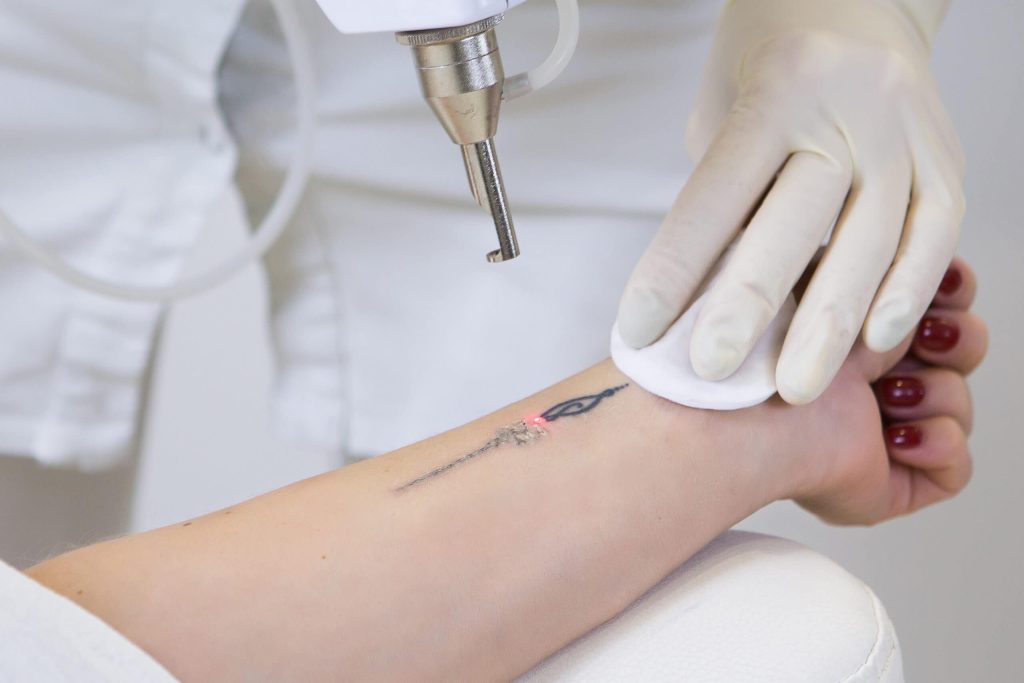Saying Goodbye to Ink: Exploring Tattoo Removal Options
Posted on: March 15, 2024
Over 75% of individuals with tattoos, including those with permanent makeup, have considered removal at some point, reflecting a growing demand for effective tattoo removal methods among patients, involving many treatments such as chemical peels. Whether it’s a change of heart, a career move, or simply the desire for a clean slate, the journey to remove an unwanted tattoo, through laser removal, scalpel, or even permanent makeup, is more accessible today than ever before, requiring many treatments. With advancements in technology and techniques, such as laser removal for tattoo pigments, saying goodbye to old ink has become less about regret and more about empowerment and transformation, with a focus on removing unwanted tattoo colors. Dive into the world of tattoo removal; understand your options, the procedure, and how patients with medical training can embark on this liberating journey with confidence, expecting a certain result.
Understanding Tattoo Removal
Basic Principle
The core idea behind tattoo removal involves breaking down ink particles, or pigments, using energy in a procedure for patients. These tattoo pigment particles, measuring in nm, are too large for the body to remove naturally without additional energy, such as in tattoo removal processes. Thus, specific methods using energy at nm wavelengths are needed to break tattoo ink into smaller pieces for patients undergoing tattoo removal. Once broken down during tattoo removal, the body’s immune system can take over, clearing away the ink fragments, including tattoo pigment particles, allowing patients’ skin to clear of tattoo pigments.
Laser technology, particularly at specific wavelengths measured in nm, stands out as the most common method for tattoo removal among patients, effectively targeting tattoo pigments. It works by emitting short pulses of intense light that penetrate the skin and get absorbed by the tattoo ink, targeting the pigments and affecting patients. The absorption of light energy causes the tattoo pigments in the ink to shatter into tiny particles, facilitating tattoo removal.
Technological Advances
Recent years have seen significant advancements in tattoo removal technology, specifically targeting pigments. These improvements have made the process not only more effective but also less painful for individuals looking to erase the pigments of their tattoos.
Modern lasers, such as Q-switched and picosecond lasers, are highly efficient at targeting tattoo pigments and ink colors with precision while minimizing damage to surrounding skin, making them ideal for tattoo removal. This precision ensures a quicker recovery and reduces the risk of scarring in tattoo removal, specifically targeting tattoo pigments.
Professional Consultation
Consulting with a professional is crucial before undergoing tattoo removal. They can assess your tattoo’s size, color depth, and skin type to determine the best treatment plan.
Professionals offer insights into what you can expect during and after tattoo removal treatment, including the behavior of tattoo pigments. They also highlight potential risks or complications based on your specific situation.

Reasons for Removing Tattoos
Career Needs
Many find that their career path demands a more conventional appearance, leading to tattoo removal due to unwanted tattoo pigments. Industries such as banking, healthcare, and education often have strict dress codes. These policies sometimes extend to visible tattoos.
They realize that to fit into these professional environments, removing an unwanted tattoo becomes necessary. This step can significantly impact their career advancement opportunities.
Personal Growth
Changes in personal taste or growth are common reasons for tattoo removal. What once was a meaningful symbol, like a tattoo, can become irrelevant or even embarrassing over time, leading to considerations of tattoo removal.
Individuals often seek to remove tattoos that no longer represent who they are today. It’s part of their journey towards self-improvement, tattoo removal, and aligning their external appearance with their current values.
Societal Perceptions
ietal views on tattoos vary greatly, but negative perceptions can influence one’s decision to remove them. In some communities, tattoos are still seen as unprofessional or inappropriate.
This societal pressure can lead individuals to reconsider their ink, especially if it affects their social or professional relationships, leading them towards tattoo removal.
Emotional Healing
Tattoos linked to past experiences or relationships can serve as painful reminders. The process of removing such tattoos is often seen as a step towards emotional healing.
It allows individuals to let go of the past and move forward with less baggage, thanks to tattoo removal. This emotional aspect is a powerful motivator in the decision to undergo tattoo removal.
Overview of Removal Methods
Laser Surgery
Laser surgery stands out as the most popular removal method. It uses concentrated light for tattoo removal to break down ink particles, which the body then naturally eliminates. This method is especially effective for dark blue and black inks in tattoo removal and can be adjusted to target different colors with varying wavelengths. However, it may require multiple sessions, depending on the tattoo’s size and age.
Laser surgery is less effective for lighter colors like yellows and greens. Patients often choose this for its precision and lower risk of scarring.
Surgical Removal
Surgical removal involves cutting out the tattooed skin and stitching the area closed. It’s a direct approach best suited for small tattoos. The process is straightforward but comes with a higher risk of scarring.
This method is considered when laser surgery might not be an option due to the tattoo’s location or when immediate results are desired.
Dermabrasion
Dermabrasion removes tattoos by sanding away the top layer of skin where the ink resides. It’s an older technique that has been largely replaced by laser surgery but can still be used for specific cases.
Dermabrasion is more invasive than laser treatments and may not be suitable for all skin types or tattoo colors. It requires careful consideration due to the healing time and potential for uneven skin texture after treatment.
Preparing for Tattoo Removal
Professional Consultation
It’s crucial to seek a qualified professional with medical training. They can offer accurate advice on removing tattoo ink safely. Their experience ensures they understand how different tattoo pigments react during removal.
Professionals guide you through the process. They explain potential risks like scarring and skin irritation. Always choose someone reputable for your consultation.
Skin Test
Before starting, a skin test is essential. It checks how your skin reacts to the removal technique. This step minimizes risks of adverse reactions.
The test involves a small area of your tattooed skin. It helps predict the outcome for larger or more colorful tattoos. Trust your specialist to conduct this safely.
Lifestyle Adjustments
Certain precautions are necessary before undergoing tattoo removal. Avoid sun exposure to prevent complications. Sun-damaged skin complicates the removal process.
Stay hydrated and follow a healthy diet. These habits support your skin’s healing after each treatment session. Your specialist might also recommend applying an antibacterial ointment as part of aftercare instructions.
Laser Surgery Explained
Light Pulses
Laser treatments target tattoo ink with intense light pulses. These pulses penetrate the skin and break down the ink into smaller particles. The body then naturally eliminates these particles.
Doctors use specific laser light wavelengths. They match these to the ink colors for maximum effectiveness. This precision ensures that surrounding skin remains unharmed.
Q-switched vs Picosecond
Q-switched lasers have been the standard for years. They deliver energy bursts in nanoseconds. Picosecond lasers, however, operate at trillionths of a second.
Picosecond lasers are more effective on stubborn ink colors and can reduce treatment time. Their speed means they shatter ink particles more finely than Q-switched lasers. Thus, they often lead to faster clearance of the tattoo.
Session Insights
A typical laser removal session lasts between 15 to 30 minutes. The frequency between sessions usually spans six to eight weeks. This gap allows the skin to heal and the body to flush out ink particles.
The total number of sessions varies widely. It depends on factors like tattoo size, color, and age. Generally, patients might need anywhere from five to fifteen sessions for complete removal.
Surgical Removal Process
Surgical Excision
Surgical excision stands as a direct approach to tattoo removal. This method involves a surgeon using a scalpel to cut out the tattooed skin. It’s most suitable for small tattoos due to the nature of the procedure.
The process begins with local anesthesia to numb the area. The surgeon then uses precision to remove the inked skin. An open wound remains, which requires stitching. These stitches bring the remaining skin together, initiating the healing phase.
Post-Operative Care
Post-operative care is crucial for healing and minimizing scars. Patients must follow their surgeon’s instructions carefully. This includes keeping the area clean and applying prescribed ointments.
Regular check-ups ensure proper healing. Avoiding sun exposure helps reduce scar visibility. It takes dedication, but these steps can lead to a successful outcome without significant scarring.
When Appropriate
Surgical removal fills a specific niche in tattoo elimination methods. It’s ideal for small tattoos where laser surgery might not be viable or preferred. In cases where laser treatment has proven ineffective, surgical excision offers a complete removal option.
This method provides certainty in removing unwanted ink but requires consideration of potential scarring and recovery time.
Dermabrasion Technique
Skin Sanding
Dermabrasion stands out as a distinctive method for tattoo removal. It involves sanding down the skin to reach the ink layers. This technique targets surface-level inks effectively.
The process can be less effective with deeper ink placements. Dermatologists often use this method when dealing with tattoos that haven’t penetrated far into the skin.
Recovery Care
After dermabrasion, the recovery phase is crucial. Patients must follow strict guidelines to avoid infection and ensure proper healing.
They should keep the treated area clean and covered. Using prescribed ointments helps in the recovery process. Avoiding sun exposure is also vital to prevent further skin damage.
In contrast to surgical removal, dermabrasion offers a non-invasive option. However, it requires careful post-treatment care to achieve optimal results. Dermatology experts emphasize the importance of following aftercare instructions closely.
Risks and Side Effects
Common Effects
After undergoing treatments for tattoo removal, individuals often experience common side effects. These include redness, swelling, and blistering around the treated area. Typically, these symptoms are temporary and resolve on their own over time. They signal the body’s immune response as it works to eliminate ink particles from the skin.
However, it’s crucial to understand that each person’s skin reacts differently. Some may see these effects subside quickly, while others might endure them for a longer period.
Serious Risks
Beyond the common reactions, there are more serious risks associated with tattoo removal procedures. Scarring tops this list as a significant concern. The process can also lead to infection if proper aftercare measures aren’t followed diligently.
Another notable risk is incomplete ink removal. Despite advancements in technology and multiple treatments, some inks prove stubbornly resistant to removal efforts. This can leave behind faint traces of the original tattoo or cause unexpected textural changes in the skin.
The heat generated by laser pulses can sometimes alter the skin’s texture, leading to roughness or unevenness not present before treatment.
Aftercare Importance
To mitigate these risks, following aftercare instructions is paramount. Proper care post-treatment can significantly reduce the chances of infection and aid in quicker recovery. It ensures that the treated area remains clean and protected from external contaminants.
Expected Results and Outcomes
Gradual Fading
Patients should anticipate a gradual fading of their tattoo. This process requires multiple sessions. Each session breaks down the tattoo ink into smaller particles. The body’s immune system then removes these particles.
The number of sessions needed varies. It depends on the tattoo’s size, color, and age. Darker colors often require more treatments than lighter ones.
Partial Removal
Complete removal without any trace is rare. Some tattoos may only partially fade, leaving a faint image or discoloration.
Factors like ink depth and skin type affect outcomes. Health care professionals can provide realistic expectations based on these factors.
Treatment Adherence
For the best results, patients must follow their treatment plan closely. This includes attending all sessions and following aftercare instructions.
Patience is crucial. The process takes time and commitment. However, adhering to the plan increases the chances of a successful outcome.
Final Remarks
Deciding to remove a tattoo is a big step. You’ve explored the reasons, methods, and what to expect during the process. Whether it’s laser surgery, surgical removal, or dermabrasion, each method has its risks and rewards. Remember, results vary, and patience is key. You’re not just erasing ink; you’re making space for new beginnings. It’s important to consult with professionals who can guide you through this journey safely and effectively. Trust in their expertise and ensure you’re fully informed about the potential side effects and outcomes.
Now, it’s time to take action. Reach out to a certified dermatologist or tattoo removal expert and discuss your options. Your journey towards removing an unwanted tattoo starts with that first step. Make it count. And remember, this isn’t just about removal; it’s about moving forward with confidence.
Frequently Asked Questions
Why do people choose to remove tattoos?
People often opt for tattoo removal due to changing personal tastes, professional reasons, or dissatisfaction with the appearance of their tattoo. It’s a personal decision influenced by various life changes.
What are the main methods of tattoo removal?
The primary methods include laser surgery, surgical removal, and dermabrasion. Each technique varies in approach and is chosen based on the tattoo’s size, location, and color.
How should one prepare for tattoo removal?
Preparing involves consulting with a qualified specialist to discuss the most suitable method for your specific case, understanding potential risks, and following pre-treatment advice to ensure optimal results.
Can you explain how laser surgery for tattoo removal works?
Laser surgery uses focused light beams to break down the ink particles in the tattoo, which are then eliminated by the body’s immune system over time, gradually fading the tattoo.
What does the surgical removal process entail?
Surgical removal involves excising the tattooed skin and stitching the remaining skin together. It’s typically recommended for smaller tattoos.
What is dermabrasion for tattoo removal?
Dermabrasion involves sanding down the skin layer containing ink to remove the tattoo. It’s a physical method that requires careful consideration due to varying effectiveness and potential side effects.
What are common risks and side effects of tattoo removal?
Risks include scarring, infection, incomplete pigment removal, and changes in skin texture. Side effects vary by method but can include pain, swelling, blistering, and temporary skin discoloration.
What results can one expect from tattoo removal?
Results vary widely depending on the removal method used, type of tattoo ink, depth of ink placement, and individual healing processes. Complete removal is possible but not guaranteed; some may experience significant fading rather than total elimination.




